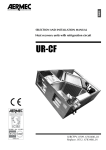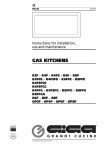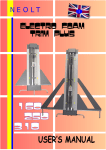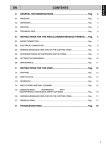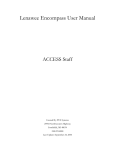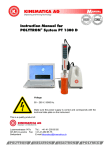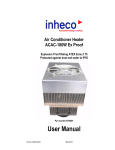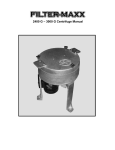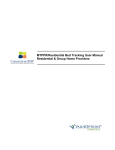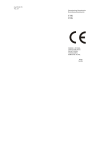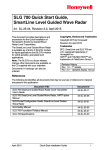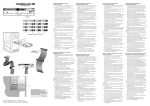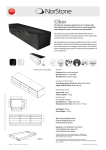Download Set up and User Manual
Transcript
Menu PA S.p.A. Technical washing equipment- ATEX PRESCRIPTIVE MANUAL for VS80 VALVES Code: 12.9228.06 ( Rev:01-Date: 07/07/2014) INSTRUCTION MANUAL FOR VALVES FOR USE IN HIGHLY EXPLOSIVE ATMOSPHERES 0- Introduction 1- Description of the product 1.1. Classification and marking 1.2. 1.1 Intended use 1.3. Terminology 2- Instructions for use 2.1 Installation 2.1.1 storage and preservation, transport and handling characteristics 2.1.2 hook-up and start-up 2.1.3 cleaning and disinfection 2.2. Utilisation and operation 2.2.1 functional description 2.2.2 intended use and prohibited use 2.2.3. danger zone 2.2.4 dangers and hazards still present 2.2.5 PPE and procedures ( training ) 2.3. Conduction 2.3.1 features of devices 2.3.2 loading and unloading maneuvers 2.3.3 starting and stopping 2.4. Precautions during inspection, routine, extraordinary and scheduled maintenance 2.4.1 inhibiting and resetting the safety devices 2.4.2. replacing parts and spare parts 2.5 Protection and repression behavior ( safeguard measures ) 0- INTRODUCTION THESE SPECIAL OPERATIVE INSTRUCTIONS MUST BE CONSULTED BEFORE PUTTING INTO SERVICE ANY DEVICE ACCORDING TO THE ATEX PRODUCTS DIRECTIVE 94/9/EC ( Decree 126/98) IN A POTENTIALLY EXPLOSIVE ATMOSPHERE AS DEFINED BY THE ATEX DIRECTIVE ON WORK ENVIROMENTS 99/92/EC (Decree 233/03) This manual is intended for the assembler/user and contains all the information useful for preventing actual ignition sources in relation to specific explosive atmospheres and for the generation of potentially explosive atmospheres by the device. The manual concerns the following phases: Handling and transport Installation and assembly Commissioning Use Maintenance and inspections by the user Precautions for residual hazards This document must be brought to the knowledge of the personnel in charge and is addressed to qualifies technical personnel and to the user of the valve and/or the machine on which it is installed. These people must carefully follow the warning reported herein. F: \Qualità\DICHIARAZIONI CONFORMITA-F\In Modifica\ManualeNormativo ATEX-Valvole_eng.doc 1 PA S.p.A. Technical washing equipment- ATEX PRESCRIPTIVE MANUAL for VS80 VALVES Code: 12.9228.06 ( Rev:01-Date: 07/07/2014) In the INSTALLATION - USE – MAINTENANCE - INSPECTION – DECOMMISSIONING phases, the user must follow the specifications of this instruction manual and comply rigorously with their own procedures regarding safety and hygiene in the workplace. Refer any repairs or communications exclusively to PA S.p.A. 1- DESCRIPTION OF THE PRODUCT 1.1 Classification and marking The valve has been produced using an evaluation, design and manufacturing process which complies the essential safety requirements of Directive 94/9EC. The valve is identified unequivocally by the data stamped on the body and by the declaration of conformity certifying that the pressurized equipment has undergone a conformity evaluation in accordance with Italian Presidential Decree 126/98, according to Enclosure VIII and that the technical pamphlet has at the same time been sent to a Notified Body. There is a single EC marking which complies with Directive 94/9/EC and therefore guarantees conformity with its requirements and with the applied standards indicated in the EC declaration. It is therefore the responsibility of the assembler to verify conformity, where necessary, with other community directives. It is understood that conformity of the device does not cover the conformity of the equipment and/or the assembled whole . Independent modifications to the valve must not be carried out, otherwise the guarantee of conformity will lapse. Therefore, in the case of installation of this accessory in a whole, as defined by the Directive itself, it is the task of the final assembler to verify suitability and reliability with the other equipment. The assembler is also obliged to carry out connection checks at the threaded and flanged connections, for which the optimum tightening conditions are indicated. The marking of the valves is as follows: T.a. 0° / + 70°C II 2 GD c TX Ex symbol: Group: Category: Substance type: Specific type of protection: Temperature class: Ambient temperature : conforming to Directive 94/9/EC II ( suitable on surface ) 2 ( suitable in Zones 1 - 2 ) G ( gas ) and D ( dust ) “c” ( construction safety ) “TX” ( see note 1 ) T.a. 0° / + 70°C The prevention and protection measures described in this manual will not determine the required safety level if the valves are not used in conformity with their intended use or are not installed and submitted to maintenance in compliance with the rules of use the appropriate requirements. F: \Qualità\DICHIARAZIONI CONFORMITA-F\In Modifica\ManualeNormativo ATEX-Valvole_eng.doc 2 PA S.p.A. Technical washing equipment- ATEX PRESCRIPTIVE MANUAL for VS80 VALVES Code: 12.9228.06 ( Rev:01-Date: 07/07/2014) 1.2. Intended use The valve object of this supply in a non-electrical device intended for a technological use for performing protection/regulation functions on pressurized equipment. It is suitable for unloading the fluids declare in the operative conditions specified in the manuals, Declaration of Conformity and Construction and Testing Certificate. The permitted environmental conditions are those described in UNI EN 1127-1 and temperatures between 0 / + 70° C, for different values, contact the manufacturer for specific study of the case. In the latter case, the evaluation of ignition hazards, protection provided against ignition, supplementary test (if necessary), manufacturer’s technical documentation and instructions for use must be authorized by PA S.p.A. according to the conditions to which the parts may be subjected during operation. If installed in a potentially explosive atmosphere, it only ensures a level of protection high enough not to generate actual ignition sources, if it is installed according to the prescriptions contained in this manual and with the correct management of the residual hazards that derive from its use. THE USER IS OBLIGED TO INSTALL SUITABLE SAFETY SYSTEM THAT PROTECT THE AREA AROUND THE WORKPLACE FROM DISCHARGES CONVEYED, IN THE EVENT THAT SUCH EMISSION LEVELS CANNOT BE TAKEN TO AT LEAST THE FIRST OR SECOND LEVEL. The device supplied guarantees the absence of ignition sources under normal operation and also in the event of the following breakdowns and/or predictable malfunctions: variation of a specification of the product to be unloaded within the permissible limits; breakdown of one of the internal constituent elements; interruption of the energy supply or other service of the process; loss of control by the operator; breakage of the seals or flange or leaks of substances caused by accidents. Minor emissions of inflammable material may occur as part of normal functioning. Faults or breakdowns in the device may occur during normal operation. If this happens, the device must be inspected to verify the cause of the breakdown. If traced to the device, the causes must imperatively be removed. The device may contain potential sources of ignition if not used under the intended conditions ( limits of use ), depending on the surrounding atmosphere, such sources may cause ignition at any time; therefore, the user takes full responsibility for zoning between the valve and atmosphere. In particular, check the temperature class defined in the Declaration of Conformity and make sure it is compatible with the classification of the areas and fluids present in the workplace (explosive range). When installed on transport vehicles and their trailers intended only for passenger transport by air, road, rail or water, given the variability of the danger zones, in each case a compatibility analysis should be carried out on the valve for the specific environment. 1.3 Terminology Qualified/specialized technician: any person trained for installation, regulation and maintenance operations; the qualified technician must be trained and qualified for these tasks and have particular knowledge of the equipment and the hazards connected with its use as well as being informed about the device's residual hazards. Device: the valve object of this manual complete with its components. Whole: the assembly with other parts or with other pressurized equipment and/or devices (see the ATEX Europe Guide, IV edition). F: \Qualità\DICHIARAZIONI CONFORMITA-F\In Modifica\ManualeNormativo ATEX-Valvole_eng.doc 3 PA S.p.A. Technical washing equipment- ATEX PRESCRIPTIVE MANUAL for VS80 VALVES Code: 12.9228.06 ( Rev:01-Date: 07/07/2014) Temperature class (T): maximum surface temperature reached by the device (also taking into account the safety coefficients of UNI EN 13463-1) – Table 1. Explosive product: all inflammable, combustible and exploding products in the form of gas, vapor, liquid, solid or a mixture of these (including dust), capable of producing an exothermic reaction with air following ignition (deflagration, detonation, explosion). PPE: personal protective equipment. Explosive range: Range of concentration of an inflammable substance in the air within which can occur an explosion, which is dependent on the minimum ignition energy of the substance Zoning: classification of the areas according to Directive 99/92/EC The other definitions not included in this manual are the same ones provided by standards UNI EN 13463-1 and UNI EN 1127-1. For dust, it is also important to evaluate the average diameter of the dust, the minimum inflammability concentration, the maximum ignition pressure and the minimum ignition energy. Compatibility between valve and atmosphere must be guaranteed by the user according to specific and precise evaluations. Verify the class temperature TX (note 1) defined into the manual and verify the compatibility with the area classification and the fluid that are present in the working place (hazardous area). Do not use fluid that can generate exothermal reactions. Fluid with auto-ignition temperature or flammability temperature less than 70°C cannot be used (consider adequate safety factor). Note 1 - the equipment will reach a max surface temperature according the used fluid, see table: Ambient Temperature temperature (° C). and fluid Temperature (GAS) From 0° to ≤ +70° Class Max surface temperature (DUST) T6 T85 °C The temperature is consider for internal ed external mechanical parts Fluid with auto-ignition temperature or flammability temperature less than the value indicated in the table cannot be used If it is possible for the process fluid to be affected by other unpredictable ( environmental and/or operative= factors; the user must take this into account when evaluating the surface temperature. 2- INSTRUCTIONS FOR USE 2.1. Installation 2.1.1. Storage and preservation, transport and handling characteristics ATTENTION: The valves are supplied properly packed. Unloading and handling the equipment must be carried out by properly trained personnel. The places used for storing, stocking and preserving, transporting and handling the valves must be guaranteed free of risks including knocks, falls, deterioration or other harmful events serious enough to jeopardize the functionality of the valves. Upon reception, it is recommended to inspect the conditions of packaging and to record any type of damage caused during transport. PA S.p.A. must promptly be informed of any possible damage so that an evaluation of the case may be carried out. F: \Qualità\DICHIARAZIONI CONFORMITA-F\In Modifica\ManualeNormativo ATEX-Valvole_eng.doc 4 PA S.p.A. Technical washing equipment- ATEX PRESCRIPTIVE MANUAL for VS80 VALVES Code: 12.9228.06 ( Rev:01-Date: 07/07/2014) The necessary precautions should also be taken when handling the valve during assembly and installation. Be particularly careful when handling, in order to avoid knocks and therefore possible deformations and cracks which could later cause possible leaks of the product contained in the equipment to be protected through the coupling points to the valve and/or possibly create actual ignition sources (sparks, adiabatic compression, etc.). 2.1.2 Hook-up and start-up ATTENTION Any installation or reinstallation must be carried out by specialized personnel who are properly trained and informed about the associated hazards and the instructions in his document. Before installation, ensure that the valve corresponds to the documents supplied. Use of tools for gases in zones 1 and 2 Steel tools (for example screwdrivers, wrenches, stands, percussion screwdriver) that may cause single sparks when used are permitted. Tools that generate a series of sparks when used for sawing or grinding, are only permitted provided the workplace is guaranteed to be free of dangerous explosive atmospheres and provided the installation, if it contains an exploding substance, is not pressurized. However, the use of steel tools is absolutely forbidden in zone 1 if there is an explosion hazard due to the presence of substances belonging to group IIC (according to the EN 50014 standard) (acetylene, carbon bisulfide, hydrogen) and hydrogen sulfide, ethylene oxide, carbon monoxide unless the workplace is guaranteed to be free of dangerous explosive atmosphere during work with these tools. ATTENTION: When using these tools, do not apply excessive rotational forces on the means of connection when there is a potentially explosive atmosphere. Use of tools for dust in zones 21 and 22 Steel tools (for example screwdrivers, wrenches, stands, percussion screwdrivers) that can cause single sparks during use are permitted. Tools that generate a series of sparks when used for sawing or grinding, are only permitted if: the workplace is protected from the rest of zones 21 and 22 and - dust deposits are eliminated from the workplace or - if the workplace is kept sufficiently damp to stop the dust spreading through the air or to prevent flameless combustion processes developing. The use of tools in zones 1, 2, 21 and 22 should be subject to a "work permit". During installation, keep to the direction of flow indicated by the arrows on the valve body and on the construction drawings. This is to enable, with the help of drainage pipes, unloading at the maximum envisaged flow rates and the absence of condensation/corrosion in the unloading compartments of the valve and in the discharge pipes, which would increase the hazard of explosion in the atmosphere. A drain pipe leading outside or to a collection tank must be provided if the discharge generates uncontrollable explosive atmospheres (discharge of inflammable fluids); where possible, the unloading point should be compatible with the other equipment installed nearby. The valve does not unload fluids capable of generating potentially explosive atmospheres (see permissibility of the fluids) The evaluation has to take into account the characteristics of the atmosphere, gas/dust conditions compared to the relative density characteristics of the air and of presumable concentrations, diameters and actual pressures adopted. F: \Qualità\DICHIARAZIONI CONFORMITA-F\In Modifica\ManualeNormativo ATEX-Valvole_eng.doc 5 PA S.p.A. Technical washing equipment- ATEX PRESCRIPTIVE MANUAL for VS80 VALVES Code: 12.9228.06 ( Rev:01-Date: 07/07/2014) The valve must be connected directly to the equipment to be protected either by means of piping not intercepted by other devices, in this case the zones in figure 1 must be translated into the corresponding unloading point. Foreign bodies must be prevented from entering into the piping far enough to reach the valve and impede the regular discharge of fluid. This is to avoid the build-up of forces on the moving parts that can produce ignition as a result of sparks generated in the movement itself due to misalignments and/or pounding. ATTENTION: The conditions of stability of the valve on the equipment to be protected must always be guaranteed by the assembler and/or user. The device must be installed according to the procedure below: Makes sure there is no obstacle between the valve and the device; place a suitable sealing gasket in compliance with standard CEI 31-30 and at least an IP54 protection rating in the case of gas and IP6X in the case of dust. Make sure that the equipment protected is not pressurized and is absolutely free of the product which it must contain; should this constitute a source of explosive atmosphere, ignition is possible due to the use of tools and/or sparks from the valve itself receiving knocks or falls (it will be necessary to inspect its condition at the beginning of the installation and during reinstallation after servicing and/or maintenance and in any case whenever the valve has been removed from the tank it protects). Couple the connection pipes (inlet and outlets) using a good technique and using components permitted in the test reports, tightening to the settings given. Whilst connecting the pipes, earth them with a cable of minimum cross-section 4mm2 in compliance with provisions for unipotential connections as stated in standard CEI 64-8. After installation, the assembler and/or user must verify that the various components are perfectly coupled to the various outlets (keep to the emission level limits considered in the zoning phase). ATTENTION: Errors in installation can cause deformation or structural yielding of the connection pipes or leaks of fluid into the environment with resulting consequences and hazards (emission of inflammable substances with relative zoning according to CEI standards concerning loss of sealing). Errors in installation can jeopardize the regular movement of the valve shutter and the pin, as well as their solid components, leading to the creation of ignition sources. Connecting devices for earthling the conducting parts All the conducting parts of the devices are arranged in such a way that a dangerous potential difference cannot exist between them when they are connected to tanks or metal equipment. If the possibility exists that insulated (by gaskets and/or grease) metal parts are charged and act as ignition sources, they must be provided with earthling terminals fitted upstream and downstream of the bolts or threads; the terminals must be interconnected. The cable and its connections must be protected from corrosion, loosening and rotation, in general they must maintain an efficient metallic contact pressure. 2.1.3.Cleaning ATTENTION: Cleaning operations are to be carried out periodically depending on the use and are obligatory in situations where foreign bodies and/or exploding dust are present on the valve and on the drains (regardless of the thickness deposited). Before carrying out periodic cleaning operations, it is absolutely essential to release the internal pressure on the protected equipment by means of the relevant pipe into a safe zone to avoid uncontrolled atmospheres being generated; F: \Qualità\DICHIARAZIONI CONFORMITA-F\In Modifica\ManualeNormativo ATEX-Valvole_eng.doc 6 PA S.p.A. Technical washing equipment- ATEX PRESCRIPTIVE MANUAL for VS80 VALVES Code: 12.9228.06 ( Rev:01-Date: 07/07/2014) verify that the unloading phase is complete by means of control devices. Then disconnect the service connections using the methods required for the use of tools and completely empty the valve of all the product inside it. For internal and external cleaning, use only non-corrosive products and solutions that are suitable for removing machining residues and do not damage the sealing surfaces and the internal parts. The above operations must not jeopardize the alignment of the internal parts and the seal between seat and valve shutter/sphere. ATTENTION: For the cleaning operations, do not use aggressive chemicals and/or mechanical systems that can cut into or deform the valve. Before reusing and/or reinstalling the VALVE, after washing or general maintenance or any other operation deemed necessary, carry out the procedure provided in point 2.1.1. 2.2. Utilisation and operation Precautions to observe during valve functioning concern the control of process parameters and correct operation. Temperature and pressure of the product being processed must never exceed the maximum/minimum permissible TS and PS values quoted on the equipment data plates and in this document. Particular care and attention must be given to any leaks and to the opening and reclosing settings of the valve if it intervenes regularly or at the wrong time. 2.2.1.Description of its operation The valve intervenes at the set calibration pressure and begins to unload the excess fluid. Experimental tests have proven and certified that the valve discharges the maximum declared flow rate within 10% of the calibration pressure; incorrectly dimensioned flow rates can cause water-hammer, pounding and/or movements that do not conform to regular use which can generate sparks of mechanical origin. The user must take particular care to correctly combine the flow rates to be unloaded and those declared, adopting suitable margins of safety as necessary. 2.2.2.Prohibited use ATTENTION: Use the valve properly within the pressure limits of the calibration range and the maximum and minimum permissible temperatures quoted on the manufacturers data plate and in the test document, which must be carefully conserved. It is strictly forbidden to tamper with or use the VALVE improperly in any way, in particular to: Change the markings on the valve Engrave, mark or stamp the valve body or any other internal or external component of the VALVE Add pieces by welding or by fixing with rivets or screws Carry out operations that can alter the mechanical properties of the material Modify the VALVE in any way ATTENTION: Under no circumstances may protection against potential ignition sources be predictably guaranteed for forces greater than the maximum permissible forces (PS - TS - speed) considered in the design phase, given the margins of safety adopted. The valve is not suitable for use in ZONE 0. THE VALVE IS NOT SUITABLE FOR CONTINUOUS UNLOADING. F: \Qualità\DICHIARAZIONI CONFORMITA-F\In Modifica\ManualeNormativo ATEX-Valvole_eng.doc 7 PA S.p.A. Technical washing equipment- ATEX PRESCRIPTIVE MANUAL for VS80 VALVES Code: 12.9228.06 ( Rev:01-Date: 07/07/2014) The use of the valve in potentially explosive atmospheres in underground areas and mines is not permitted, for these areas devices from the M1 group are required. Regulating or recalibrating the valve is not permitted. The PA S.p.A. Company declines all liability for damage to persons, animals or objects deriving from the improper use of the equipment and/or the failure to observe the provisions contained in this instruction manual. 2.2.3. Danger zones Special attention must be reserved to any potentially explosive zone around the valve. Keep away from the internal parts of the valve. ATTENTION: It is strictly forbidden to work on the tightening elements and other connections while the equipment is running and in any case whenever the area might contain a potentially explosive atmosphere. If you need to work on the valve with tools (maintenance and cleaning) take suitable measures to make certain that the zone is free from such risks; keep to the prescriptions on the use of tools. 2.2.4. Dangers and hazards still present Hot surfaces Valves always represent a danger due to hot surfaces. Since they can be used in varying processes, it is not possible to know in advance the temperature they will reach (function of the process temperature); the manual gives the temperature classes in relation to the TS of the valve, the user must take into account the fact that the temperature of all the surfaces of the devices and components which can come into contact with explosive atmospheres must not be greater than the minimum ignition temperature for the combustible gas or liquid (or mixture) used, expressed in °C, during normal operation and in case of malfunctions. However, in the event that it is impossible to rule out the gas or vapor being heated to the surface temperature, this surface temperature must not be greater than 80% of the minimum ignition temperature of the gas, measured in °C. These values can only be exceeded in case of rare malfunctions. In special cases, the above temperature limits can be exceeded if it is demonstrated that ignition is not expected. Naked flames and hot gases Naked flames are not permitted, except in the cases described below: Devices with flames are only admitted if the flames are safely confined and if the temperatures of the external surfaces of the parts of the installation specified in table 1 are not exceeded. The air necessary for combustion can be drawn from zones 1, 2, 21 and 22 only if the dangers are avoided by taking the appropriate protection measures (isolation of the explosion EN 1127-1). Hot gases can only introduced if it can be guaranteed that the minimum ignition temperature of the explosive atmosphere cannot be reached. It must be guaranteed that the deposited dust will not ignite. In addition, preventive measures (for example the use of spark arresters) must be taken to make sure there are no solid articles coming from the burnt gases. Sparks of mechanical origin Sparks are ruled out during normal operation and/or in case of malfunctions and are caused by friction, knocks or abrasion sparks and pounding. In particular, friction between aluminum (excluding alloys containing less than 10% of aluminum and paints and coatings with less than 25% of their weight in aluminum) and iron/steel (except stainless steel where the presence of rust particles can be ruled out) must be avoided. F: \Qualità\DICHIARAZIONI CONFORMITA-F\In Modifica\ManualeNormativo ATEX-Valvole_eng.doc 8 PA S.p.A. Technical washing equipment- ATEX PRESCRIPTIVE MANUAL for VS80 VALVES Code: 12.9228.06 ( Rev:01-Date: 07/07/2014) Devices intended to be used in gas/air, vapor/air and smoke/air explosive atmospheres that may produce sparks of mechanical origin must be ruled out if the potential exploding atmosphere may contain one or more Devices intended to be used in gas/air, of the following gases: acetylene, carbon bisulphide, hydrogen, hydrogen supplied or ethylene oxide, unless it has been proven that no risk of explosion exists. Ultrasounds (dangers of an acoustic nature) During measurements of equipment thickness with ultrasound methods and if dangers due to ultrasound have been identified, in the zone around the valve the following specific requirements must be observed: Ultrasound waves with a frequency greater than 10 MHz must not be allowed, except in cases in which the absence of a risk of ignition has been proven for the case in question demonstrating that there is no absorption by molecular resonance. For ultrasonic waves with frequencies up to 10 MHz, the use of ultrasonic waves must only be allowed if the safety of the work procedure is ensured. The power density of the acoustic field generated must not be greater than 1 mW/mm2, unless it has been proven that, for the case in question, ignition is impossible. In work procedures with conventional ultrasound devices (for example test devices using ultrasound echoes), special protection measures against the risk of ignition deriving from the ultrasonic waves are only necessary if the power density of the acoustic field generated is greater than 1 mW/mm2, unless it has been proven that, for the case in question, ignition is impossible. Lightning If dangers due to lightning have been identified, the installations must be protected with appropriate measures for protection against lightning (CEI 81-4 and CEI 81-1). Stray electric currents and protection against cathode corrosion All conducting parts of the system which are part of the electrical material or are adjacent to it must be protected in compliance with standard EN 50154. Unipotentiality for all conducting parts of the system must be carried out for use in explosive dust /air mixtures, even for those parts not adjacent to the electrical material - and this unipotentiality must be effected in compliance with standard EN 50154. If conducting parts of the system enter into zone 21, for example ventilation and suction pipes into the tanks, they must first be connected to the unipotentiality system. Static electricity The most important protection measure consists in earthling all the conducting parts which could become dangerously charged. In this case, dangerous charge levels of the non-conducting parts and materials, including solids, liquids and dust must be avoided. During the intended use of the installations, including maintenance and cleaning or during normally predictable malfunctions, discharges capable of provoking ignition must not occur. Electrostatic discharges of devices or parts of these adjacent to the valve When the propagation of sparks following highly efficient charging of non-conducting layers and coatings on metallic services may occur, this can be prevented by making sure that the discharge voltage through the layers is less than 4 kV. For devices in the IID group, to be used only in the presence of dusty atmospheres with a minimum ignition energy greater than 3 mJ (measured with a capacitive discharge), electrostatic discharge capable of causing ignition, including F: \Qualità\DICHIARAZIONI CONFORMITA-F\In Modifica\ManualeNormativo ATEX-Valvole_eng.doc 9 PA S.p.A. Technical washing equipment- ATEX PRESCRIPTIVE MANUAL for VS80 VALVES Code: 12.9228.06 ( Rev:01-Date: 07/07/2014) the propagation of sparks, can also be prevented by making sure that the thickness of the non-conducting layer is greater than 10 mm. The devices surrounding the valve (non-metallic components) are designed in such a way as to avoid danger of ignition due to electrostatic discharges during use, maintenance and cleaning. This requirement is fulfilled in one of the following ways: by means of a suitable selection of material so that the surface resistance of the sheath is no greater than 1 GW at (23 ± 2) °C and with relative humidity of (50 ± 5)%; by means of the dimension, form and configuration or by means of other protective methods in such a way in that dangerous electrostatic discharges cannot occur. by means of limiting the projecting surface area (limits of the EN 13463-1 standard) in one direction of nonconducting parts of the devices that can be electrostatically charged even though the propagation of sparks cannot occur. In order to prevent sparks forming and causing ignition, the thickness of layers or coatings of solid plastic materials (nonconductors) on earthed metal surfaces (conductors) that can be charged in group IIG devices must be no greater than 2 mm for group IIA and IIB group gases and vapors or no greater than 0.2 mm for group IIC gases and vapors. Adiabatic compression and shockwaves Processes that can cause adiabatic compression or shockwaves are not tolerated. Generally, dangerous compression and shockwaves can be eliminated if, for instance, the separations and the valves between the sections of the system in which high pressure ratios are present can only be opened slowly. If devices, protection systems and components containing highly oxidizing gases must be used, special precautions to prevent ignition of construction and auxiliary materials must be taken. Exothermic reactions, including self-ignition of dust When substances of this type have to be handled, the necessary protection systems must be applied case by-case. The following protection measures can be applied: making them inert; making them stable; facilitating heat dispersion, for example dividing the substances into smaller quantities; limiting the temperature and the pressure; stocking at lower temperatures; limiting contact time. A preliminary analysis must be carried out if there is the possibility of the valve material reacting dangerously with the substances handled. Excessive vibration and stress ATTENTION: Stress due to vibration, above all if transmitted by connection pipes and other connected equipment, is not permitted. Where these conditions cannot be guaranteed, suitable measures must be taken to minimize such phenomena. Counter pressure Excessive counter pressure at unloading has a negative effect on the valve and does not allow it to open at the set calibration values; as a result, unloading capacity is lower than that declared, pounding and compression on the valve shutter occur and sparks are possible. F: \Qualità\DICHIARAZIONI CONFORMITA-F\In Modifica\ManualeNormativo ATEX-Valvole_eng.doc 10 PA S.p.A. Technical washing equipment- ATEX PRESCRIPTIVE MANUAL for VS80 VALVES Code: 12.9228.06 ( Rev:01-Date: 07/07/2014) The drain pipe must be free of set counter pressure (suction in the direction of flow to the drain is not allowed). The connection pipe to the valve must favor the flow of fluid without inducing excessive pressure loss A downward slope for the drain pipes is recommended. Environmental hazards Environmental conditions other than those specified by standard UNI EN 1127-1 may constitute a source of danger. Dangerous service conditions (in relation to the fluids processed) can include rough handling, the effects of humidity, environmental temperature and variations in pressure, the effects of chemical agents and corrosion. Work processes in the adjacent installations must be carried out in such a way that they do not have a dangerous effect. Always split inflammable substances up into smaller quantities and at the same time keep only small quantities of a substance in one particular place; even in the case of large volumes this can be beneficial in terms of safety. Ventilation and accumulations Ventilation is of primary importance for controlling the effects of the emissions of combustible gases and vapors. It can be used on the outside of the device For dust, ventilation generally only provides sufficient protection when the dust is extracted from its place of origin (localized aspiration) and only if dangerous deposits of combustible dust are avoided; alternatively, perform aspirated or manual dust removal. Emission of dust from devices, protection systems and components that can be opened during normal operation must be expected (for example in the transfer points or in the inspection and cleaning openings) or in case of malfunctions. The device, protection system and component that contains the dust may be protected by creating a pressure that is slightly lower than the environmental pressure (aspiration), or by carefully collecting the dust at its source or point of emission (localized aspiration). In order to prevent an explosive atmosphere being formed due to the effect of dust deposits being dispersed in the air, periodically clean the valve keeping the layers within the permitted limits, considering also the surface temperatures of the valve. Use in a whole The assembler of the whole on which the valve is installed must take an comprehensive approach in particular for complex devices, protection systems and components; for installations which include special units and above all for extensive installations he must carry out a risk analysis which takes into account the danger of ignition and explosion deriving from: calculation of the probability that determines an explosive atmosphere and the implied quantity (in compliance with 5.2 of standard UNI EN 1127-1 ); limits of use of the valve itself interaction between devices, protection systems and components and the substances processed the specific industrial process realized in devices, protection systems and components; interaction of the individual processes in different parts of devices, protection systems and components; the environment surrounding devices, protection systems and components and possible interaction with nearby processes. F: \Qualità\DICHIARAZIONI CONFORMITA-F\In Modifica\ManualeNormativo ATEX-Valvole_eng.doc 11 PA S.p.A. Technical washing equipment- ATEX PRESCRIPTIVE MANUAL for VS80 VALVES Code: 12.9228.06 ( Rev:01-Date: 07/07/2014) Care must be taken over the electrical material included in the atmosphere that may generate electrical sparks and create hot surfaces (opening and closing of circuits, loose connections, stray currents); all electrical materials must comply with Directive 94/9/EC and be compatible with the valve category. 2.2.5. PPE and procedures (training) The choice of PPE to be employed when using the machine is the responsibility of the user, who must also provide training about the risks connected to the fluid used and symptomatology due to unexpected events. All personnel assigned to cleaning, maintenance, assembly, disassembly and inspection must be properly instructed about the residual hazards of the respective operations concerning the use of PPE and/or the correct execution of the maneuvers and the conditions for resetting the valve. The professional training of qualified/specialized workers must comply with heading XV-c A of Decree 233/03 and as a minimum must contain in-depth guidance regarding the following topics associated with the use of the valve: Protection measures against explosions Measures against the generation of electrostatic charges for both carriers and generators of charges (materials, workers clothing) Use of installations, equipment, protection systems and all suitable connection devices (Ex and/or EC certification) Design, control, use and maintenance of predictable hazards Use of optical and acoustic signaling, evacuation systems, possible energy cutoffs and consequent dissipation Any instrumentation to be used for measures and painting must comply with the following standards: EN 50054 – Electrical apparatus for the detection and measurement of combustible gases. EN 50057 - Electrical apparatus for the detection and measurement of combustible gases – Prescriptions relating to the performance requirements for Group II apparatus indicating up to 100% lower explosive limit. EN 50058 - Electrical apparatus for the detection and measurement of combustible gases – Prescriptions relating to the performance requirements for Group II apparatus indicating up to 100% (V/V) gas. EN 50059 - Prescriptions Specification for electrostatic hand-held spraying equipment for non-flammable material for painting and finishing. 2.3. Conduction 2.3.1. Characteristics of the devices Under no circumstances can protection from ignition sources be predictably guaranteed for temperatures greater than the maximum permissible temperature declared on the manufacturer's data plate, given the margins of safety adopted. Under no circumstances can protection from the generation of ignition sources be predictably guaranteed for pressures greater than the maximum permissible pressure declared on the manufacturer's data plate, given the margins of safety adopted. The safety system also depends on the control, regulation and protection devices (in conformity with Directive 94/9/EC); it is imperative that these are independent from the safety valve. 2.3.2. Loading and unloading maneuvers The valve installation procedures must be such that they guarantee that the protective equipment is filled and emptied under safe conditions, in particular: - filling must take place in the absence of a potentially explosive atmosphere; - once the procedure for use and the absence of atmosphere have been verified, fill the equipment with the proper fluid, avoiding any spillages onto the valve. F: \Qualità\DICHIARAZIONI CONFORMITA-F\In Modifica\ManualeNormativo ATEX-Valvole_eng.doc 12 PA S.p.A. Technical washing equipment- ATEX PRESCRIPTIVE MANUAL for VS80 VALVES Code: 12.9228.06 ( Rev:01-Date: 07/07/2014) ATTENTION: Appropriate means must be provided for emptying and bleeding in order to allow cleaning, inspection and maintenance operations to be carried out under totally safe conditions. 2.3.3. Starting and stopping In the case of doubts or irregular operation, stop the production process, refrain from carrying out hasty repairs and contact qualified personnel. ATTENTION: In the event of unexpected opening of the protection device, take the pressure back to zero and proceed with inspection, taking care to thoroughly clean any residual fluid from the coupling connection to the protection device and to the device itself. If the safety valve has intervened, ensure that the safety device has actually closed again. 2.4. Precautions during inspection, routine, extraordinary and scheduled maintenance Removable parts cannot not be accidentally or carelessly removed. This is guaranteed by the adoption of removable fastening devices which can only be removed by means of a tool or a wrench, and then only for maintenance and/or cleaning after ensuring that there is no external and/or internal potentially explosive atmosphere. To carry out the periodic cleaning operations, the internal pressure has to be released by means of a pipe leading to a safe zone to avoid damage to persons and objects and then a check must be made that the discharge phase is complete by means of the control devices (pressure gauge). Checks must always be carried out to ensure the non-existence of potentially explosive atmospheres and the impossibility of ignition resulting from said atmosphere. The user must make certain that operators are properly instructed to ensure they are capable of implementing all workplace safety and hygiene procedures according to internal protocol, such that any risk deriving from the operations quoted above may be avoided. 2.4.1. Inhibiting and resetting the devices ATTENTION: During operation it is absolutely forbidden to block, tamper with or bypass the valve. Removing the valve from the equipment is only allowed when the equipment is not pressurized and in the absence of a potentially explosive atmosphere and for checking the efficiency of the device itself (e.g. test bench calibrations) or during maintenance/replacement. After reinstalling the safety device, before putting the pressurized equipment back into operation, check that there is a proper seal between the connection and the device and that the device is effective (§ 2.1.2.). 2.4.2. Replacing parts and spare parts Replacing parts of the head may not guarantee the design conditions stipulated by PA S.p.A. the head and/or its components must be replaced when, at the user's discretion, they no longer guarantee safety functions under ordinary operating conditions. 2.5. Protection and repression behavior (safeguard measures) Integrated safety against explosions aims at preventing the formation of explosive atmospheres as well as ignition sources and, in the event that an explosion should occur, immediately stifling it and /or limiting its effects; in this regard, the user must take appropriate measures to minimize the risks of explosion (in accordance with Decree 233/03). F: \Qualità\DICHIARAZIONI CONFORMITA-F\In Modifica\ManualeNormativo ATEX-Valvole_eng.doc 13 PA S.p.A. Technical washing equipment- ATEX PRESCRIPTIVE MANUAL for VS80 VALVES Code: 12.9228.06 ( Rev:01-Date: 07/07/2014) This evaluation process must always be applied to each individual case and therefore there is no general solution. In particular, in compliance with article 4 of Directive 1999/92/EC, the following must be considered: the probability and duration of the formation of dangerous explosive atmospheres, the probability of the presence and the activation of ignition sources, installations, substances employed, working processes and their possible interactions as well as the dimension of the probable effects. The user must keep to what has been prescribed in order to: avoid, as far as possible, the formation of explosive atmospheres (concentration limits) – classification of areas apply suitable control systems avoid the formation of actual ignition sources (prevention of the ignition source) In all circumstances in which a potentially explosive atmosphere cannot be avoided, it must be monitored and/ or measured using, where applicable, alarm indications and suitable safety coefficients which create an alarm threshold located far beyond the outer limits of the explosion and/or ignition. Following an explosion, the affected parts of the system should be checked in order to evaluate whether the devices, protection systems and components can still be used safely. F: \Qualità\DICHIARAZIONI CONFORMITA-F\In Modifica\ManualeNormativo ATEX-Valvole_eng.doc 14














